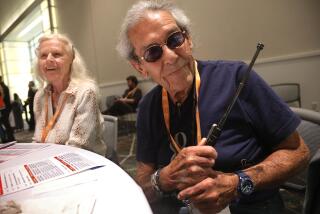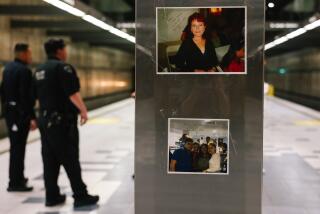Train-Crossing Deaths Leave a Trail of Grief : Son Tries to Find Meaning in Ironic Death of Mother on Del Mar Tracks
- Share via
Naveen Waney remembers the evening with disturbing clarity. It was just last week, and he had brought home a college architecture project to discuss with his parents, a practice that was typical for the close-knit La Jolla family of five.
After all, when it came to her son’s school work, Usha Waney was always a woman of gentle challenges. She sat at the dinner table, listening to his vision for a new train station in Solana Beach.
When the 26-year-old son was finished, his mother added one caveat: That the new station should avoid the design flaw that plagued the Del Mar depot--where rail passengers often dash across the tracks to catch their trains.
Exactly one week later, Usha Waney died on those same train tracks--at the very station she had expressed concerns about over that prophetic family dinner.
“It’s just so ironic,” Naveen Waney said Thursday, standing outside the family home as he shivered in the autumn morning chill. “My mom was concerned about how dangerous that crossing was.”
“She thought something should be done about it, like building a pedestrian bridge over the tracks, a precaution to keep someone from getting hurt.”
For the 47-year-old Waney, a San Diego clothing designer who traveled frequently by train, her own insightful suggestions came too late.
At 6:35 Wednesday morning, just after she parked her car in a private parking lot on the west side of the tracks, Waney and a handful of other rail passengers heard the warning bell sound at a nearby crossing.
Mistaking the freight train warning for that of their Los Angeles-bound Amtrak train, the group of strangers ran through the parking lot toward the red-brick Del Mar depot.
Waney, who carried a briefcase full of business papers and fabric samples, immediately fell behind the others. Then, as the full-speed freight train loomed within several hundred yards, she stumbled on the tracks in front of the platform--striking her head on the steel rail.
As 2 dozen morning commuters watched in disbelief, Lee Kaiser and his wife, Roberta Halpern, dashed out to try to help the dazed Waney. But the train was too soon upon them.
Waney died instantly as the wheels of the locomotive pulled her beneath its powerful frame. Halpern, a researcher at a local cancer institute, suffered severe head injures and died several hours later. Her husband was not seriously injured.
The untimely deaths have shaken Kaiser and the usually reserved Waney family, who came to the United States from India in 1972. Their mother always had been the solid rock of their clan, a driven career woman who stubbornly reserved time to care for the family--especially her ailing husband and mentally handicapped daughter.
But the loss has been particularly hard for Naveen, who looked up to his mother both for her emotional support and intellectual guidance.
A student with considerable training in architectural design, he cannot understand why that dangerous, unsanctioned rail crossing was allowed to be used for so long.
There is even a bike rack and trash can at the spot, he reasons, along with wooden planks laid down like a welcome mat--as if to encourage people to use the shortcut. And a fence that runs between the parking lot and the tracks stops right at the crossing point.
“Architects are supposed to think about how people will react within the spaces they create. So why does the fence just stop right there at the crossing?” he asked. “If they know people are going to cross there, why don’t they do some work and make the crossing level so there aren’t rocks and railroad ties to trip over.
“And why aren’t there any signs warning people of the danger? It’s like these people are saying, ‘You’re on your own. You’re taking a risk. So get ready to pay the consequences.’ ”
Santa Fe Railway officials say the pathway is not a public crossing and should not be used, even though it often saves hasty commuters from walking 25 yards south to a paved crossing.
“It’s not our fence, and it’s not on our property,” Santa Fe spokesman Mike Martin said Thursday. “The ugly fact of life is that two people died at that spot. And now people are going to line up asking questions of liability, questions I can’t answer.”
Del Mar city officials say the case may have to go to court to decide who is responsible for the upkeep of the crossing.
Meanwhile, John King, owner of the parking lot west of the depot, said he plans to erect a fence in an effort to force train passengers to use the safer nearby crossing at Coast Boulevard.
On Wednesday night, Naveen Waney and Michelle Six, his girlfriend of seven years, returned to the Del Mar depot “to see things with my own eyes, like an architect is trained to do.”
The son wanted to sit on the tracks to witness what his mother would have seen when the big train barreled down on her.
“I wanted to walk in my mom’s footsteps,” Naveen said, “to trip where she tripped, to see what it felt like to walk on those tracks.”
He sat there on the polished steel rails in the darkness--until an Amtrak passenger train pulled into the station.
“I’ve seen passenger trains like that one before in my life but never was it as scary as last night,” he said. “At first, the train wasn’t there. And then it was. And you can imagine what a freight train must have been like.”
As he perched on the tracks, Naveen posed in his mind the same questions that had tortured his whole family over the previous 12 hours:
What if his mother had been only five minutes later? What if she had fallen only a few inches farther? And, for just one moment, did her hustle-bustle career make her fatally careless?
In his mind, Naveen Waney has an image of his mother as dedicated career woman who never let her family down.
“The pressure of her job in the clothing industry made her grow strong,” he recalled. “There were nights when she stayed up past midnight working, waiting for calls from Hong Kong or somewhere else. But she always made time for her family.
“She was always there, and she had an answer for everything. And there wasn’t one night that she didn’t ask me how things were going at school--where I was going with my life and how long it was going to take me to get there.”
Usha Waney had a favorite saying for her only son. “One day you’re going to be a famous architect,” she would tell him, “and you’re going to buy your mother that Mercedes-Benz she’s always wanted.”
For the time being, however, Usha Waney proudly drove her 1985 Renault Alliance. She had felt better about the car after a private dealer left a note one day on her windshield explaining that the car was a classic, and that she should take care of it.
“After that, it was her thing at parties to say she had this classic old car,” her son recalled. “She owned a collector’s item.”
Waney prized not only her car. She loved her job as a production manager for a San Diego clothing company where her husband also worked.
For years, the job took her around the world--to South America and the Orient. And, more recently, to Los Angeles several times a week on the passenger train.
Several years ago, Hashu Waney, now 58, suffered a serious heart attack. With his wife’s help, he pulled through and eventually returned to work.
Back then, he told her he had gotten well only for her, and that he could not go on living without her.
“They were married back in India all those years ago,” Michelle Six recalled. “They had an arranged marriage, and they always admitted that they didn’t love each other when they were married. But they fell in love. I’ve never seen two people so in love.”
Now Naveen and his 29-year-old sister, Shalina, are worried about their ailing father and their 23-year-old sister, Nita, who can’t understand that her mother is gone forever.
Throughout much of Wednesday, the family huddled at their La Jolla home, receiving friends and keeping vigil on the condition of Halpern, the stranger who eventually died after trying to save their mother’s life.
When they went to bed that night, the children all slept in the same bed with their father, as if to prepare him for the many long nights ahead of him when his beloved Usha would not be there.
Naveen awoke at 5 a.m. Thursday and went to his drawing board to transfer to paper the nagging sensations in his heart and mind.
Before dawn on the first full day without his mother, he sketched some possible corrections for the crossing where she died. The picture showed a smooth surface where passengers could cross the rails without tripping.
Naveen’s sketch also carried the following epitaph:
“I woke up this morning and sighed in relief. What a bad dream!” he wrote. “Boom! Reality struck!! No, it wasn’t a dream, this happened, all in one day, and for my mom, all in seven seconds.
“Oh mom, I love you!”
More to Read
Sign up for Essential California
The most important California stories and recommendations in your inbox every morning.
You may occasionally receive promotional content from the Los Angeles Times.














